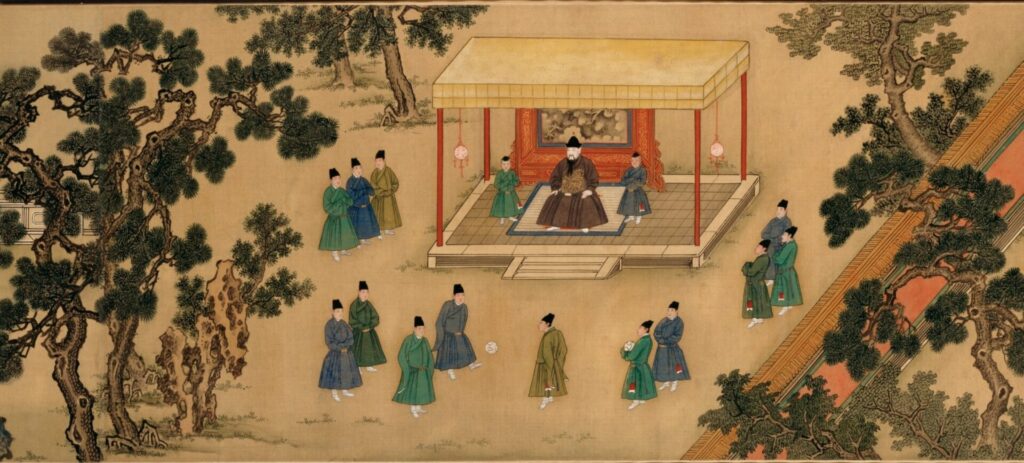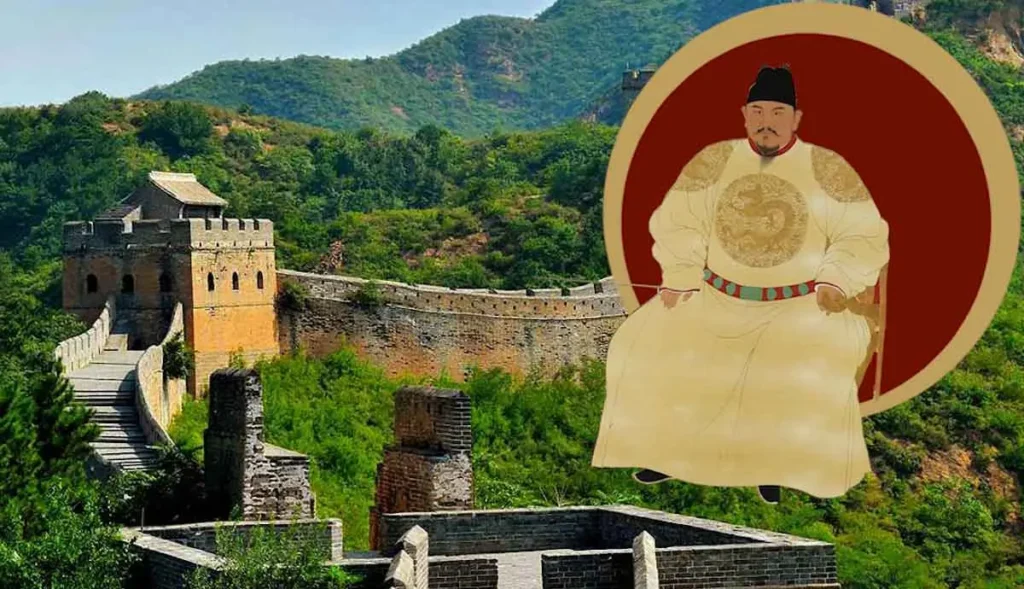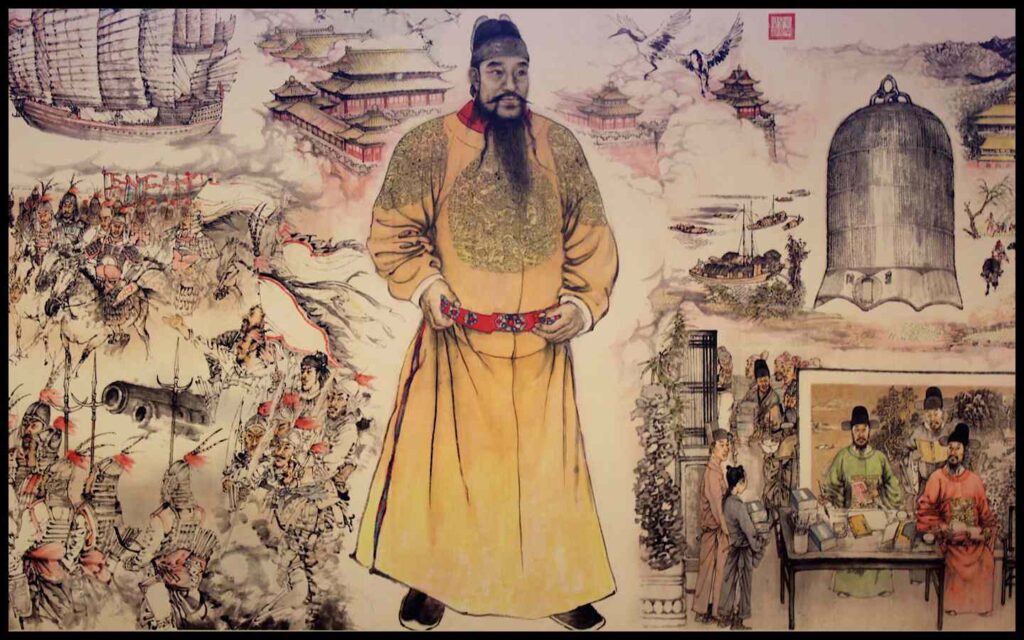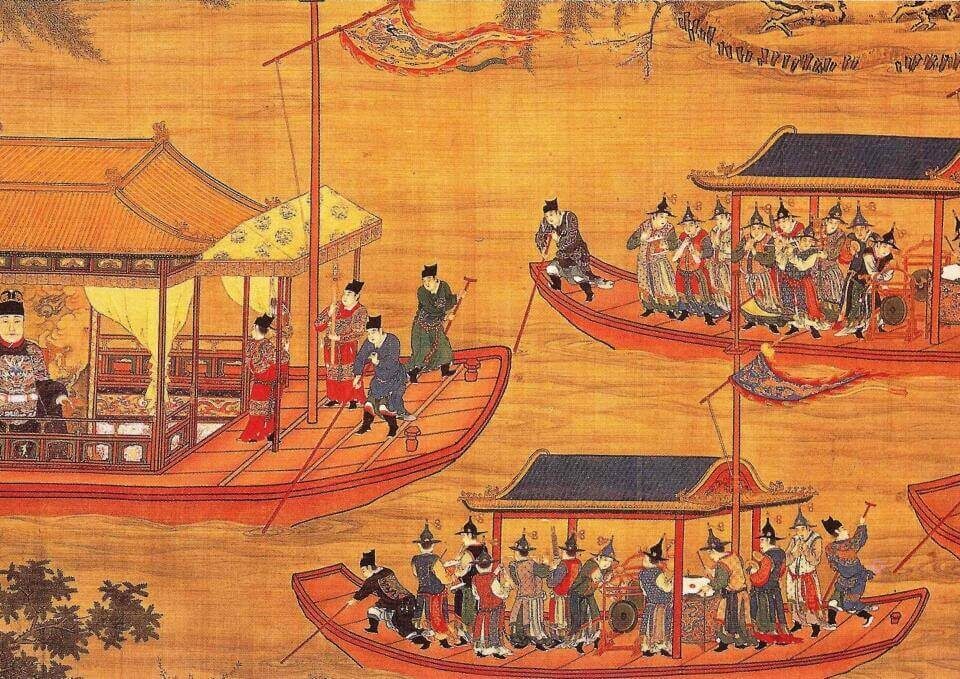The Ming Dynasty stands as one of the most remarkable epochs in Chinese history, characterized by both grandeur and turbulence. Spanning from 1368 to 1644, this dynasty witnessed unparalleled advancements in culture, art, and technology, alongside internal strife and external threats. Understanding the rise and fall of the Ming Dynasty offers invaluable insights into the complexities of imperial rule in ancient China.
Just as dynasties have risen and fallen over time, fashion trends have evolved. From the opulent robes of Ming Dynasty officials to the casual comfort of modern men’s t-shirts, clothing styles reflect both the grandeur of the past and the simplicity of contemporary life.
Origins and Establishment

The Ming Dynasty emerged amidst the chaos of the Mongol-led Yuan Dynasty’s collapse. Zhu Yuanzhang, a former Buddhist monk turned rebel leader, rose to prominence, rallying support from disgruntled peasants and military commanders. With strategic brilliance and popular backing, Zhu overthrew the Yuan, establishing the Ming Dynasty in 1368. He ascended the throne as Emperor Hongwu, marking the beginning of a new era.
Under Hongwu’s reign, the Ming Dynasty laid the groundwork for centralized governance and bureaucratic systems. The emperor initiated agrarian reforms to alleviate the plight of peasants, redistributing land and curbing the power of aristocratic landowners. He established the capital in Nanjing, signaling a symbolic departure from the Mongol influence and reaffirming Han Chinese cultural identity. Hongwu’s military campaigns consolidated Ming control over vast territories, securing the dynasty’s dominance in the region.
During the Ming Dynasty, folks were busy creating beautiful art, writing amazing stories, and making fancy pottery. They even built the Forbidden City in Beijing, showing off their awesome building skills and how fancy they were. People were also doing lots of trading, both on land along the Silk Road and by sailing across the seas, which helped them learn cool stuff from other cultures and make lots of money. And hey, speaking of making things, some folks were also getting creative in the kitchen, whipping up delicious treats like cookie dough edibles.
Golden Age and Cultural Renaissance
The reign of Emperor Yongle, the third Ming emperor, marked a golden age of expansion and innovation. Yongle’s ambitious maritime expeditions, led by the famed admiral Zheng He, showcased Ming China’s naval supremacy and global outreach. These voyages not only demonstrated the dynasty’s power but also facilitated diplomatic relations and trade with distant lands.
Yongle’s patronage of the arts and sciences fueled a cultural renaissance, attracting scholars, poets, and artisans to the imperial court. The Yongle Encyclopedia, a monumental compilation of Chinese knowledge, epitomized the era’s intellectual achievements. The Ming Dynasty witnessed the pinnacle of Ming porcelain craftsmanship, exemplified by the exquisite blue-and-white ceramics produced during this period.
Advancements in agriculture and technology bolstered the dynasty’s economic prosperity and social stability. The introduction of new crops, such as maize and sweet potatoes, revolutionized farming practices and increased agricultural productivity. Innovations in printing techniques led to the widespread dissemination of literature and knowledge, laying the foundation for a literate society. Amidst these developments, the emergence of a thriving beauty salon in Toronto became a symbol of urban sophistication and style, catering to the grooming needs of the growing populace.
Decline and Internal Strife
Despite its early successes, the Ming Dynasty began to face internal challenges and external pressures that would ultimately lead to its downfall. The later years of the dynasty were marred by corruption, bureaucratic inefficiency, and fiscal mismanagement. Eunuchs gained unprecedented influence within the imperial court, undermining the authority of the central government.
Social unrest and peasant uprisings erupted across the empire, fueled by economic hardship and agrarian grievances. The Red Turban Rebellion, led by the White Lotus Society, posed a significant threat to Ming rule, culminating in the capture of Nanjing in 1644. The fall of the Ming Dynasty marked the end of Han Chinese rule and the rise of the Qing Dynasty, founded by the Manchus.
Just as the Ming Dynasty navigated periods of prosperity and decline, providing health care services for veterans in Dallas TX requires adaptability and resilience to meet the changing demands of those who have served their country.
Legacy and Cultural Impact
Despite its eventual demise, the Ming Dynasty left an indelible mark on Chinese history and culture. Its architectural marvels, such as the Great Wall and the Temple of Heaven, continue to inspire awe and admiration. Ming porcelain remains highly prized by collectors worldwide, reflecting the dynasty’s artistic achievements.
The Ming Dynasty’s emphasis on Confucian values and scholarly pursuits shaped the moral and intellectual fabric of Chinese society for centuries. Confucianism became the dominant ideology under Ming rule, influencing governance, education, and social ethics. The Ming era also witnessed the proliferation of classical Chinese literature and the refinement of traditional art forms, leaving a rich cultural legacy that endures to this day. If you’re intrigued by the historical twists and turns of the Ming Dynasty, you might also be fascinated by the captivating performances of a corporate magician in Orange County. Just as the dynasty witnessed both peaks and declines, a skilled magician can weave spells of wonder and entertainment to captivate audiences in corporate settings.
Economic Policies and Trade Networks

The Ming Dynasty implemented a series of economic policies aimed at promoting agricultural productivity and fostering commercial growth. Land reforms initiated by Emperor Hongwu aimed to redistribute land to peasants, thereby increasing agricultural output and reducing rural poverty. The dynasty also encouraged the development of new crops, such as maize and sweet potatoes, which bolstered food security and stimulated population growth.
Ensuring a solid foundation is akin to the strong leadership that sustained the Ming Dynasty through its peaks and pitfalls. With expert assistance in foundation repair in Fort Worth, homeowners can fortify their homes against potential damages and ensure long-term stability.
Trade played a vital role in the Ming economy, with extensive networks connecting China to regions as far-reaching as Southeast Asia, India, and the Middle East. Maritime trade flourished, facilitated by the voyages of Admiral Zheng He and the establishment of maritime silk routes. The port city of Quanzhou emerged as a bustling center of international trade, attracting merchants from diverse cultural backgrounds.
Despite its outward focus, the Ming Dynasty also implemented protectionist measures to safeguard domestic industries. Trade regulations were enforced to limit the influence of foreign merchants and preserve the dominance of Chinese merchants in local markets. The dynasty’s mercantilist policies aimed to maintain a favorable balance of trade and protect the interests of the imperial treasury.
Just as the Ming Dynasty experienced periods of prosperity and decline due to political, economic, and social factors, pharmacy consulting faces shifts driven by changes in healthcare regulations, pharmaceutical technology advancements, and consumer preferences.
Religious and Philosophical Movements
The Ming Dynasty witnessed a resurgence of religious and philosophical movements, reflecting the diverse spiritual landscape of medieval China. Confucianism remained the dominant ideology, shaping the moral and ethical framework of society. Confucian scholars played influential roles in government administration, education, and social hierarchy.
Alongside Confucianism, Daoism and Buddhism continued to exert significant influence on Chinese culture and spirituality. Daoist practices, such as qigong and tai chi, gained popularity as methods for cultivating health and longevity. Buddhist monasteries served as centers of learning and refuge, attracting devotees seeking spiritual enlightenment and salvation.
Just as the Ming Dynasty architects paid close attention to detail in constructing monumental structures, modern-day fence installation in St Augustine meticulously plans and executes the installation process to ensure durability and longevity.
The Ming era also saw the rise of syncretic movements that blended elements of Confucianism, Daoism, and Buddhism. The White Lotus Society, for example, espoused a syncretic belief system that emphasized salvation through faith and moral purity. These movements provided spiritual solace to the masses and challenged the orthodoxy of imperial authority.
Intellectual Discourse and Literary Achievements
The Ming Dynasty was a golden age of intellectual discourse and literary creativity, characterized by the proliferation of classical Chinese literature and scholarly pursuits. The imperial court patronized scholars and intellectuals, fostering a vibrant cultural milieu conducive to intellectual exchange and artistic expression.
Just as the Ming Dynasty laid the foundation for China’s cultural and architectural legacy, door installation in New Jersey now plays a crucial role in shaping the aesthetic and security features of modern homes.
Literary works from the Ming era encompassed a wide range of genres, including poetry, prose, drama, and historical chronicles. Notable literary figures such as Tang Xianzu, playwright of the famous “Peony Pavilion,” and Feng Menglong, compiler of vernacular short stories in “Jin Ping Mei,” left enduring legacies that continue to shape Chinese literature.
Scholarly pursuits flourished in the Ming Dynasty, with scholars engaging in rigorous textual analysis, philosophical debate, and historical research. The compilation of the Yongle Encyclopedia, a monumental literary endeavor spanning over 22,000 volumes, epitomized the era’s commitment to knowledge preservation and dissemination.
If you’re studying the Ming Dynasty, you should know that modern innovations like UI/UX design services play a crucial role in presenting historical information to contemporary audiences.
Technological Innovations and Scientific Advancements
The Ming Dynasty witnessed significant technological innovations and scientific advancements that transformed various aspects of Chinese society. In the realm of agriculture, the introduction of new crops and farming techniques revolutionized agricultural practices, increasing food production and sustaining population growth.
Advancements in printing technology facilitated the mass production of books and literary works, democratizing access to knowledge and education. Woodblock printing techniques allowed for the rapid dissemination of texts, fostering a literate society and stimulating intellectual inquiry.
In the field of astronomy, Ming scholars made groundbreaking discoveries and observations, contributing to the refinement of the Chinese calendar and celestial navigation. The construction of astronomical observatories and the development of precision instruments enabled astronomers to chart the movements of celestial bodies with unprecedented accuracy.
Similar to the ingenuity displayed during the Ming Dynasty, loan origination software represents a modern marvel, revolutionizing the lending industry with its streamlined processes and advanced capabilities, showcasing how ancient legacies inspire contemporary advancements.
Foreign Relations and Diplomacy
The Ming Dynasty maintained extensive diplomatic relations with neighboring states and distant empires, shaping the geopolitical landscape of East Asia and beyond. Diplomatic missions were dispatched to tributary states such as Korea, Japan, and Vietnam, reaffirming China’s suzerainty and cultural superiority.
The Zheng He voyages, a series of maritime expeditions led by the eunuch admiral Zheng He, showcased Ming China’s naval power and global outreach. These voyages facilitated diplomatic exchanges, trade negotiations, and cultural diplomacy, strengthening China’s influence in Southeast Asia, the Indian Ocean, and the Persian Gulf.
Despite its outward engagement, the Ming Dynasty also faced challenges from nomadic tribes on its northern frontier. The Ming-Qing border conflicts, particularly with the emerging Manchu power, foreshadowed the dynasty’s eventual decline and the subsequent rise of the Qing Dynasty.
Much like the meticulous record-keeping of the Ming Dynasty officials, apostille services uphold standards of verification and authentication, bridging the gap between historical practices and contemporary legal requirements.
Legacy and Impact on Modern China

The legacy of the Ming Dynasty continues to resonate in modern China, shaping various aspects of contemporary culture, society, and governance. The dynasty’s architectural marvels, such as the Forbidden City and the Temple of Heaven, stand as enduring symbols of Chinese civilization and imperial splendor.
Ming porcelain remains highly prized by collectors worldwide, reflecting the dynasty’s artistic achievements and technical craftsmanship. The influence of Ming aesthetics can be seen in contemporary Chinese art, ceramics, and design, preserving a link to the past while embracing the innovations of the present.
Confucian values and philosophical traditions rooted in Ming culture continue to inform Chinese social ethics, governance, and education. The emphasis on moral integrity, filial piety, and social harmony remains relevant in navigating the complexities of modern society. From ancient dynasties to modern cities, the thread of protecting communities from harm persists, illustrating the timeless relevance of proactive measures such as home pest control in Reno in safeguarding our homes and environments.
Conclusion
In conclusion, the Ming Dynasty stands as a testament to the complexities and contradictions inherent in dynastic rule. Its rise from humble beginnings to imperial grandeur, marked by achievements in art, culture, and governance, exemplifies the heights of human ingenuity and ambition. However, the dynasty’s eventual decline and fall underscore the fragility of power and the challenges of sustaining dynastic rule amidst internal strife and external pressures.
Despite its demise, the Ming Dynasty’s legacy endures in the cultural, artistic, and intellectual heritage of China. Its architectural marvels, technological innovations, and literary achievements continue to inspire awe and admiration, serving as reminders of a bygone era of splendor and innovation. Moreover, the Ming Dynasty’s emphasis on Confucian values and ethical principles continues to shape Chinese society and governance, providing a foundation for social harmony and moral integrity.
Understanding the rise and fall of the Ming Dynasty is essential for comprehending the complexities of Chinese history and its enduring impact on the modern world. By examining the triumphs and tribulations of this remarkable dynasty, we gain valuable insights into the cyclical nature of history and the resilience of human civilization in the face of adversity. As we reflect on the lessons of the Ming Dynasty, we are reminded of the importance of preserving cultural heritage, fostering intellectual inquiry, and upholding the values of justice, virtue, and compassion in our own time.

